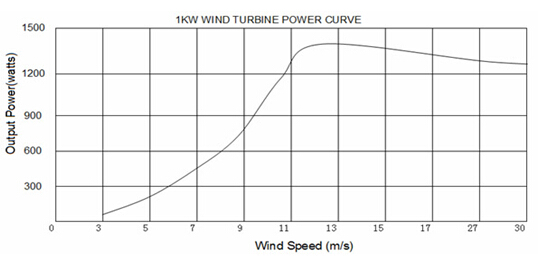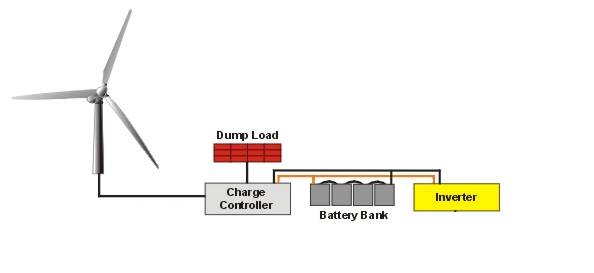ZONHAN wind turbines are made of strong cast steel that makes them durable.ZONHAN wind turbines can withstand harsh environments like strong winds and cold weather.Using high performance NdFeB permanent magnet, the alternator is high efficient and compact. The unique electro-magnet design makes the bonding force and cut-in speed very low.
1. Introduce
A home wind turbine is a device used for generating electricity in a residential setting, harnessing wind energy and converting it into electrical power. It typically consists of a rotating wind rotor and a generator. As the wind rotor spins, it converts the wind energy into mechanical energy, which is then converted into electrical energy by the generator.
Horizontal axis wind turbines are the most common type. They resemble the large commercial wind turbines and have three main components: the wind rotor, the tower, and the generator. The wind rotor usually consists of three or more blades that automatically adjust their position based on the wind direction. The tower is used to mount the wind rotor at an appropriate height to capture more wind energy. The generator is located behind the wind rotor and converts the mechanical energy into electrical energy.
The advantages of home wind turbines include:
Renewable energy: Wind energy is an infinite renewable source, reducing reliance on traditional energy and minimizing environmental impact.
Cost savings: By using a home wind turbine, households can reduce the amount of electricity purchased from the grid, resulting in energy cost savings.
Independent power generation: Home wind turbines can provide a source of power during power outages or unstable grid supply, offering an independent power source.
Environmental friendliness: Wind power generation produces no greenhouse gases or pollutants, making it environmentally friendly.
2.Structure and Main performance
ZONHAN turbines are made of strong cast steel that makes them durable.ZONHAN turbines can withstand harsh environments like strong winds and cold weather.Using high performance NdFeB permanent magnet, the alternator is high efficient and compact. The unique electro-magnet design makes the bonding force and cut-in speed very low.
3. Main technical performances
Rotor Diameter (m) | 2.8 |
Material and number of the blades | Reinforced fiber glass*3 |
Rated power/maximum power | 1000/1500w |
Rated wind speed (m/s) | 10 |
Startup wind speed (m/s) | 2.5 |
Working wind speed (m/s) | 3~25 |
Survived wind speed(m/s) | 45 |
Rated rotate speed(r/min) | 400 |
Working voltage | DC24V/48V |
Generator style | Three phase, permanent magnet |
Charging method | Constant voltage current saving |
Speed regulation method | Yaw+ Auto brake |
Weight | 56kg |
Tower height (m) | 9 |
Suggested battery capacity | 12V/200AH Deep cycle battery 4pcs |
Life time | 15years |
4. Application principles
Wind Resource Assessment: Before installing a home wind turbine, it is crucial to assess the wind resource at your location. The wind speed, direction, and consistency play a significant role in determining the viability of wind power generation. Conduct a wind resource assessment or consult with experts to ensure that your location has sufficient wind resources for effective power generation.
Site Selection: Choose an appropriate site for installing the wind turbine. Ideally, the site should have unobstructed access to the prevailing wind direction, away from tall buildings, trees, or other structures that can create turbulence and disrupt the wind flow. The turbine should be positioned at a sufficient height to capture maximum wind energy, which may require a taller tower.
Local Regulations and Permits: Check the local regulations and obtain any necessary permits or approvals required for installing a home wind turbine. Some areas have specific rules regarding the height, noise levels, and visual impact of wind turbines. Adhering to these regulations ensures a smooth installation process and mitigates any potential legal issues.
System Sizing: Properly size the wind turbine system based on your energy needs and the available wind resources. Consider your average electricity consumption and determine the turbine capacity and number of turbines required to meet your requirements. Oversized or undersized systems may lead to inefficient power generation or excess power wastage.
System Integration: Integrate the wind turbine system with your existing electrical infrastructure. This typically involves connecting the turbine to an inverter or charge controller to convert the generated DC power into AC power compatible with your home's electrical system. Ensure that the system is properly wired and follows electrical safety standards.
Maintenance and Safety: Regular maintenance is essential to keep the wind turbine operating efficiently and safely. Follow the manufacturer's guidelines for maintenance tasks such as inspecting the turbine, lubricating moving parts, and checking electrical connections. Adhere to safety protocols and exercise caution when working near or on the wind turbine.
Grid Connection and Net Metering: If you plan to connect your wind turbine system to the electrical grid, consult with your local utility provider to understand the grid connection requirements and net metering policies. Net metering allows you to sell excess power generated by your wind turbine back to the grid, offsetting your electricity consumption.


Contact: James Ye
Tel: 86-13867770817
Whatsapp: 86-13867770817
Email: zonhan@zonhan.com
Add: HEADQUARTERS ECONOMIC PARK, YUEQING,ZHEJIANG,CHINA